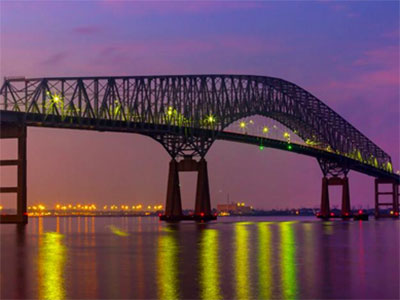

The Francis Scott Key Bridge Collapse
Horribly, a container ship collided with the Francis Scott Key Bridge, and much of the bridge collapsed. Cars went into the water, and it has become a deadly disaster. Our thoughts go out to the families impacted.
As we commented in Inc., from a supply chain point of view, it has caused significant near-term impacts and extended disruptions in the region. Transportation bottlenecks immediately emerged. Container ships, trucks, and rail were all impacted.
Port Impacts
It just so happens that the collapse of the bridge cut off the Baltimore port by in essence setting up a wall between the port and the Chesapeake Bay. The bridge’s collapse means that for the foreseeable future, it won’t be feasible to get to the container terminals. The port is likely to remain closed for several months and traffic diverted. This port is the 5th largest container port on the U.S. East Coast and the busiest port in the region for handling roll-on/ roll-off cargo such as cars, light trucks, construction and farm equipment, and more. The port also handled sugar, furniture, home appliances, coal, and other items.
Near-term, container ships will be diverted to nearby ports such as New Jersey, Pennsylvania, and Virginia ports. There will be delays, congestion, and diversions. Most likely, these delays will be relatively short-term as they are absorbed to nearby ports; however, it is another disruption in the global supply chain with short-term and long-term implications. As we communicated in a recent article on the impacts of the drought conditions in the Panama Canal and container ship attacks in the Suez Canal (both impacting shipments from Northeast Asia to the East Coast), this is an additional disruption at the East Coast ports. Thus, some shippers are likely to divert to the West Coast ports and rail or truck product to the East Coast.
Regional Logistics Impacts
There are 3,200 sites involved in logistics, distribution and warehousing nearby the port and bridge. Thus, there will be severe near-term disruption in the region. The timing will be heavily dependent on how quickly the debris can be cleared to restore safe passage in the area. Some experts believe this task could be accomplished in the next 1-2 weeks whereas others say it could take months. With that said, with the ports closed and diversions underway, it will take time for the supply chain to level out.
Trucking Impacts
According to the American Trucking Associations (AMA), almost 4,900 trucks travel the bridge each day, with $28 billion in goods crossing each year. There are alternate routes; however, there are issues associated with several of the options. For example, the two tunnel options to cross Baltimore harbor cannot carry hazardous materials, and there are height and width restrictions on the tunnels. Thus, trucks will be diverted on I-695 on the western side of the city. These diversions will cause additional delays, diversions, and cost.
Industry Impacts
The auto industry will experience the most significant impacts because the Baltimore port is the top American port for the import and export of cars. BMW, Volkswagen and Mercedes-Benz have facilities close to the port to handle vehicle shipments, and Mazda is had the highest dollar value of imports. The auto industry supply chain will be resilient but it will be another disruption after finally returning inventory to pre-pandemic levels.
The energy industry might experience disruption as well. There could be a disruption in coal supplies, gasoline and ethanol. The oil industry will have to find alternate routes for barge deliveries and/or pursue alternate modes of transportation (trucking). CSX transports imported coal and is communicating expected delays.
SIOP & Backups
It is quite clear that a single backup is no longer sufficient. You must proactively plan for likely risks and think 3 steps ahead of your competition to succeed in today’s global supply chain. SIOP (Sales Inventory Operations Planning) is a process to align demand with supply. It provides visibility across the supply chain so that companies can take proactive actions to mitigate risks, source backup sources of supply, and pivot with changing circumstances. For example, there is significant regional manufacturing, reshoring, and nearshoring occurring. To learn more about these strategies, download our complimentary book, SIOP: Creating Predictable Revenue and EBITDA Growth.
If you are interested in reading more on this topic:
How Do You Rate in Your Supply Chain?


